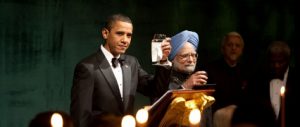There was a time, not long ago, when the idea of a national low-carbon growth strategy for India would have been hard to imagine. “Low carbon” was seen to be at loggerheads with India’s ambitious economic-development agenda and was too controversial a concept to find a voice in domestic politics. Yet in January 2010, prime minister Manmohan Singh established a 26-member expert group to help develop a low-carbon growth strategy for India. The group, which hosts a formidable array of members from government, industry, academia and civil society, is being chaired by Dr Kirit Parikh, former member of India’s Planning Commission.
Anna da Costa: What led to the formation of the low-carbon expert group?
Kirit Parikh: I think it’s quite clear that India realised it is vulnerable. It is in its great interest to have an international agreement to reduce carbon emissions and, from our own energy security point of view, there are many things we should do to move to low-carbon growth. Whatever measures we can take that can stimulate and nudge the global community into a global agreement are also in our interests. This leads us to examine the options, the costs, the alternatives and the multiple benefits of moving to a low-carbon development pathway.
AC: What types of recommendation can we expect to emerge from the group and how will this work differ from, or connect to, India’s National Action Plan on Climate Change?
KP: The National Action Plan outlines the long-term measures that we should take. It doesn’t have the required specificity in terms of what needs to be done and we hope the low-carbon strategy will provide more detailed guidelines as to what measures can be taken. India has committed to meeting a reduction in national energy intensity of 25% by 2020. We need to work out a strategy and the various specific measures that will enable us to meet this.
AC: This seems like a major task. Is all of the analysis being conducted by the expert group or are you outsourcing certain elements?
KP: The expert group, which has 26 members, has a very wide-ranging set of expertise. It is a wide group of stakeholders, many of whom have been working on this subject for a long time. We will pool the knowledge that exists [in the group] and put together a menu of what is possible. Time is very short, so we cannot do any further new research as such. We are very open to any outside help, or contributions. We will put these recommendations out in an open, transparent manner, put them on the website, seek comments and so on – and might even hold a public consultation on them at some stage.
AC: Do you think the 25% energy-intensity target you mention, which was announced by India before the Copenhagen climate conference, can be met with the current National Action Plan strategy?
KP: You know, there are many things we are doing already. India’s energy intensity has been coming down in any case. Business-as-usual projections should provide a fairly large part of the reduction we want to achieve. A little more effort should bring [energy intensity] down to the 25% [target]. I don’t think there should be that much of a challenge or difficulty in doing that.
AC: Is the aim of the low-carbon expert group to reduce India’s emissions beyond what would likely occur on a business-as-usual trajectory?
KP: It’s to make sure we meet the 25% reduction in carbon intensity, to see if we can do even more and what kind of support we will need to reach that target. What can we do? What is win-win? What policies do we need? Are there barriers? Do we need finance? These are the kinds of questions that we need to answer.
AC: A few years ago, it seemed as though using the words "low-carbon development" as an element of India’s political vocabulary would have been politically untenable. What has enabled this change? And does it signify a fundamental shift in thinking on the issue of climate change and development in India?
KP: This is difficult to answer. I think you could give a lot of credit to the prime minister, who felt that, although the rigid stand we had been taking in the past was morally and ethically correct, we need to get the logjam moving and should take some initiative. That is why at the Gleneagles conference [of the G8 in 2005, which India, China, Brazil, Mexico, and South Africa attended] he promised that we are determined to have our per-capita emissions never exceed those of industrialised countries.
The western world didn’t think that was any commitment, but if you think about it, that itself was a major commitment. Why? Because if we want to reach [greenhouse-gas concentrations of ] 450 parts per million by 2050, the average of industrialised countries will come to 2.5 to three tonnes per capita and India will have to restrict itself to three tonnes per capita, which is a huge commitment. So we are very willing to get the process moving. We are interested in getting a global agreement. That is part of the strategy. Let’s get the process moving.
AC: How likely is it that the recommendations of the low-carbon expert group will be implemented? What factors will need to be in place to see this happen?
KP: I’ve chaired enough committees to know that not all recommendations get implemented. There are always political considerations. There are always stakeholders who have vested interests of various kinds. So I would not say that I expect all of our recommendations will be implemented. What is important about these expert committees and groups is that they create a consensus and awareness amongst people so that, in due course, things change and pick up.
AC: Do you have a sense of how much India’s low-carbon strategy is estimated to cost? To what degree is the government funding these initiatives and how much is it hoped that finance will also come from the private sector and international public funds?
KP: My feeling is that there are lots of things we can do that pay for themselves and don’t involve any additional costs but have multiple benefits. Energy efficiency, for example, pays for itself. I think there are many [options] like that. But, of course, finance is required up front too. Without such finance, we know that many economically attractive actions are not taken up by industry and individuals. But I cannot answer this question until we have done our work.
AC: In your long experience of working on India’s economic development, you must have seen many kinds of sustainable-development solutions. What are some of the most transformative solutions you believe exist for India?
KP: I think there are three solutions that show [particular] potential for the goal of sustainable development. First is definitely solar technology – and making it cost-competitive with coal as soon as possible. That could bring a hugely transformative change. Second would be a major programme of rainwater harvesting and watershed development. This could transform the whole water and agricultural scenario and is clearly of importance. Third, if one were to speak in terms of the future, maybe the development of cellulosic ethanol [a biofuel produced from wood and plants] could make India truly energy independent. This is looking [at the question] from the energy sustainability perspective.
But there are many, many things that have contributed to India’s inclusive development. Inclusion is critical for sustainability. The National Rural Employment Guarantee Act began in Maharashtra [a state in west India] and is now across the country. You could say the Gram Swarojgar Yojana [a rural micro-enterprise initiative] is also transformative. You might say that if you can get 100% literacy and school attendance for all children up to 14 years, then that could be transformative. There are many things that we could do that really could make a tremendous difference to the economy. Of course, support for public transport in major metro areas can also be transformative.
AC: Global negotiations tend to focus on what India needs to absorb from other parts of the world, particularly in terms of finance and technology. But do you feel there are areas where India has a lot to share with other countries in terms of global efforts to combat climate change and shift toward sustainability?
KP: It is very clear that India is not just an absorber of technologies; it can really be a generator, inventor and developer. Again, I support prime minister Manmohan Singh’s suggestion at Gleneagles that we should set up a network of collaborative institutions at the international level like the Agricultural Research Institutes under the Consultative Group on International Agricultural Research. If we can have that kind of institutional set-up for low-carbon or renewable technology and have the intellectual-property rights shared globally as global public goods, that could be very important.
Anna da Costa is a Worldwatch Institute fellow based in New Delhi.
Homepage image from Ashden Awards



